Challenging a New Source Review Equipment Replacement Loophole
The new source review program was designed to reduce air pollution from industrial facilities as it requires them to adopt modern pollution controls whenever equipment changes are made that increase air pollution. The loophole would have allowed 17,000 power plants, refineries and other industrial facilities to install replacement equipment without updating pollution controls, even in situations when new equipment increases air pollution.
Case Overview
In October 2003, the Bush Administration made revisions to the Clean Air Act that would allow thousands of aging power plants and other industrial facilities nationwide emit more air pollution, threatening the health of millions of Americans. Soon after, Earthjustice filed a court order to stop the administration from implementing the rule change, as it would create a loophole in the Clean Air Act’s “new source review” program. The loophole would allow 17,000 power plants, refineries and other industrial facilities to install replacement equipment without updating pollution controls, even in situations when new equipment increases air pollution.
Air pollution from refineries, chemical and power plants contribute to tens of thousands of premature deaths and hundreds of thousands of asthma attacks every year. The new source review program was designed to reduce air pollution from industrial facilities as it requires them to adopt modern pollution controls whenever equipment changes are made that increase air pollution. The Bush Administration’s rule derails clean air standards and would add to the over $50 billion dollars of health related costs from air pollution.
In December 2004, an appellate court blocked the rule from taking effect, but in 2005 the Environmental Protection Agency rejected the request to abandon the adoption of weaker clean air standards. The EPA’s decision ignored the implications of the earlier ruling and showed the agency’s commitment to upholding polluter-friendly rollbacks over the objections of state quality officials and the public. Then in March 2006, a federal court ruled that the Bush administration’s revisions would have sabotaged key provisions of the Clean Air Act. Earthjustice’s litigation efforts were able to close the gaping loophole and enforce regulations on the nation’s worst polluters.
In November 2006, the U.S. Supreme Court heard arguments from the Environmental Protection Agency, who filed a lawsuit against Duke Energy for failing to upgrade pollution controls after undertaking major renovation at eight coal-fired power plants. In April of 2007, the Supreme Court ruled that that the New Source Revision under the Clean Air Act requires Duke’s plants to install up-to-date pollution controls, as the renovations to their power plants increased the amount of air pollution released each year.

Case Updates
Case page created on November 23, 2005.
